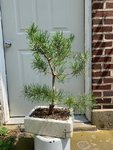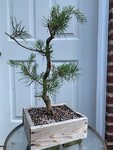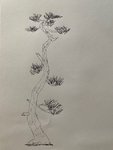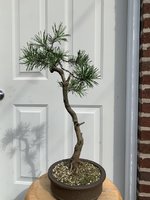PA_Penjing
Chumono
I have owned this Pinus banksiana just shy of 2 years so there's not much to look at right this moment. But, I don't want to be that guy who doesn't show his work. So I'll begin the public record today. This tree was collected from some mountain in Massachusetts. I am not the collector, the first picture shows what the pine looked like the spring after I purchased it, really nothing to look at there... wish I had the fall photo when it was even rougher when I bought it. I trimmed it that fall, and have been cutting candles down each spring. You can see in the photos that nearly every branch is going to need to be removed. I repotted in the summer of 2019, most of the soil was earth/duff left over from collection and it was staying very moist. But the biggest reason for the repot was because I had been/was going to be removing large amounts of foliage as fast as the tree would allow. I will probably reduce the root mass again next summer. The second photo is a picture of the tree currently, still nothing but a mess of sacrifice branches, unfortunately you cant see in the photo but the apex is a pretty thick mass of short healthy branches, with some wire I can have whatever structure I want up there. To be clear, I am trimming candles on the few short "keeper branches" and was allowing the big branches I couldn't remove that year to extend. I am missing a picture of the tree at some point with a pretty wicked leader coming off the side.
I made a sketch of my future path with the few branches that I'm actually keeping on the tree. I tried my best to draw the trunk true to form but I see that I may have given it a little extra spice. Because I still probably have two years of branch removal ahead there's a chance the trunk will thicken up a hair to match the sketch. To be fair I sketched it at eye level and took the photo from slightly above so it has a tiny bit more taper than the photos suggest, oops. Lastly I attempted my very first approach graft on the trunk (picture 4) and I'm not very confident it will/has taken. So I made notes on the sketch to reflect how I would deal with this. I won't check the graft until next summer. I wonder if it's because the branch originates above the graft? I couldn't find a straight answer on google , I blame my verbiage I guess. But google has totally gone downhill, anyone else notice that?
To date it's a whole lot of nothing I suppose. I am aware that I am pushing this tree pretty hard, pretty fast but I am seeing nothing but lush dark needles and back buds when they'd be expected. In it's current state it's a pretty sad sight to look at, I will certainly take my foot off the gas when I see this thing rounding third. Will update this thread annually.
I made a sketch of my future path with the few branches that I'm actually keeping on the tree. I tried my best to draw the trunk true to form but I see that I may have given it a little extra spice. Because I still probably have two years of branch removal ahead there's a chance the trunk will thicken up a hair to match the sketch. To be fair I sketched it at eye level and took the photo from slightly above so it has a tiny bit more taper than the photos suggest, oops. Lastly I attempted my very first approach graft on the trunk (picture 4) and I'm not very confident it will/has taken. So I made notes on the sketch to reflect how I would deal with this. I won't check the graft until next summer. I wonder if it's because the branch originates above the graft? I couldn't find a straight answer on google , I blame my verbiage I guess. But google has totally gone downhill, anyone else notice that?
To date it's a whole lot of nothing I suppose. I am aware that I am pushing this tree pretty hard, pretty fast but I am seeing nothing but lush dark needles and back buds when they'd be expected. In it's current state it's a pretty sad sight to look at, I will certainly take my foot off the gas when I see this thing rounding third. Will update this thread annually.








